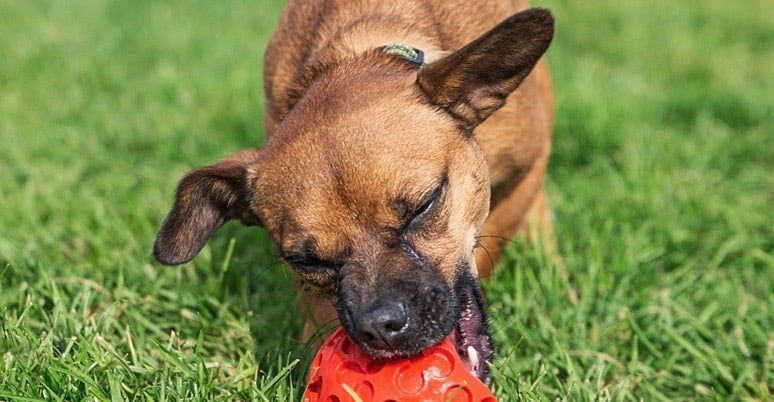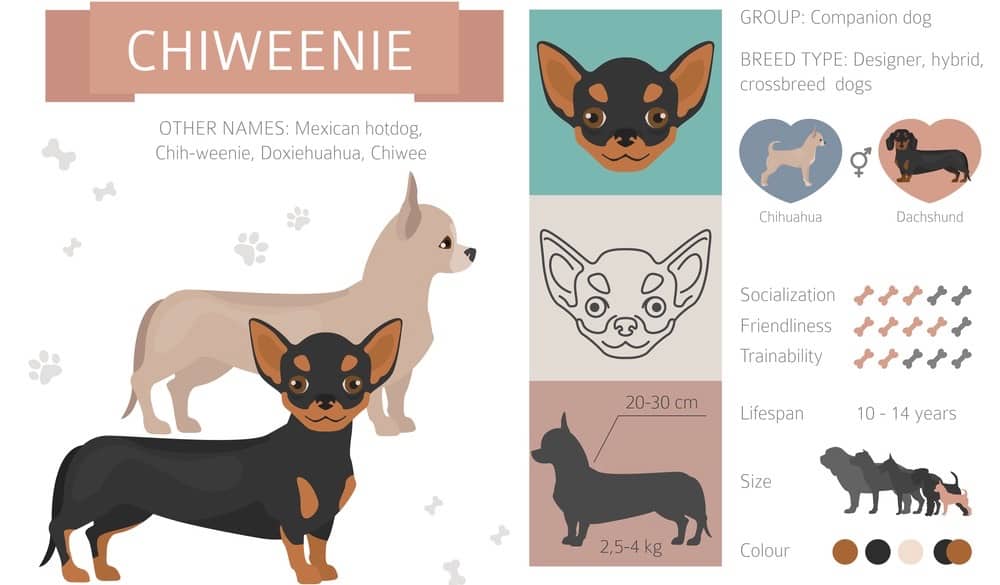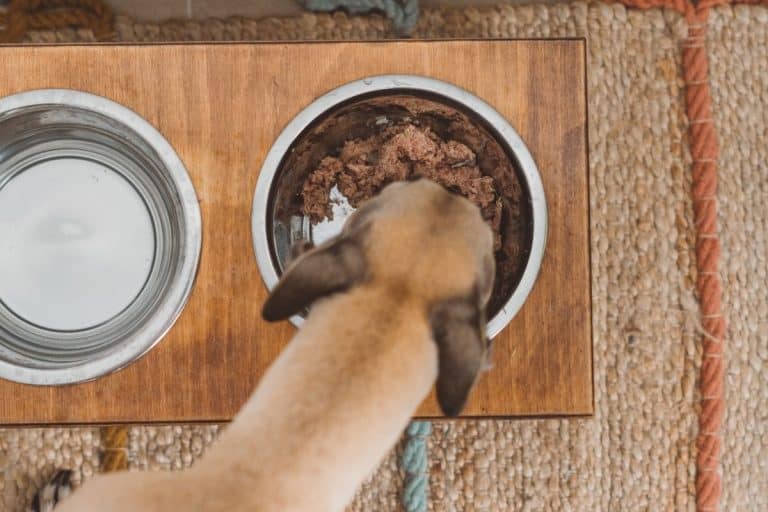Chiweenie Growth Chart – Size & Weight Chart
A Chiweenie is a hybrid of the Dachshund and Chihuahua and is a spirited, lively, affectionate crossbreed that makes the perfect companion dog.
If you have a Chiweenie or looking to get one, you must be wondering how big they get when they are adults.
As adults, Chiweenies stand at a height of between 6 to 10 inches and weigh between 5 and 10 pounds.
This article will provide you with more information about the Chiweenie growth chart including their growth stages and many more!
When Is A Chiweenie Fully Grown?

Chiweenies reach their adult weight and height early on in life because they are a small dog breed. Most Chiweenies are almost fully grown when they reach the ages of between 8 and 10 months.
Then they will continue to fill out, meaning they gain muscle mass, and their chest gets broader. However, these changes are minimal and may not have a big effect on your puppy’s weight.
If the coat of your Chiweenie is long, it will continue to grow and reach its full length when they are about 10 months old.
However, if the coat is short your puppy will have adult fur around the age of 4 to 6 months. Your female Chiweenie will stop growing after her first heat cycle if you spay her, which can be around the age of 6 to 10 months.
Chiweenie Size Chart
Monitoring your Chiweenie weight chart will enable you to give them the right amount of food to ensure that they remain healthy and fit.
Providing your puppy with a balanced and complete diet as well as adequate exercise according to their age will ensure that they maintain a healthy weight throughout their life.
If your puppy is not the right weight, they are at a high risk of diseases such as diabetes, heart disease, and joint problems.
Therefore, consult with your vet to ensure that they are not overweight or underweight and they can give you guidelines on how you can help your puppy maintain their weight.
At 3 months, a Chiweenie weighs around 2 pounds, at 5 months they weigh around 5 pounds, at 8 months they weigh around 8 pounds, and at 10 months they weigh around 10 pounds.
Chiweenie Weight Chart
| Size | Standard Chiweenie | Mini Chiweenie |
|---|---|---|
| Weight | 12 - 15 lbs | 4 - 5 lbs |
| Height | 8 - 10 inch | 6 - 7 inch |
| Full Grown | 10 - 12 months | 8 - 10 months |
Chiweenie Growth Chart – What To Expect

Birth – 2 Weeks
This is the neonatal stage where the puppy depends entirely on the mother for care like keeping themselves clean. They also depend on the mother for their nutrition as the mother’s milk has all the nutrients that the puppy needs to grow.
If the mother cannot produce enough milk, the puppy should be fed puppy formula to ensure that they get the nutrition they need.
Their ears and eyes are not yet open, and they spend most of their time eating and sleeping. At this stage, the puppies have minimum movement and are only capable of crawling slowly.
3 Weeks – 12 Weeks
At around the age of three and four weeks, the puppy starts interacting and becoming aware of the littermates. Their senses of hearing and sight develop fully by the age of five weeks.
During this stage, the puppy’s baby teeth emerge, they begin to bark, walk, and wag their tail. The puppies will also be able to eliminate without their mother’s help.
Weaning starts at the age of four weeks and by eight weeks the puppies can eat solid foods and transition to their new home.
This is also the period to vaccinate the puppies and train them on socialization skills and potty training so that they can interact with other people and pets.
4 Months – 9 Months
This is the stage where the puppy begins to show dominance and wants to be the leader in the pack. You must train them on obedience and socialization skills.
The puppy may also experience a fear phase which can last for up to a month, and there is no need to worry as this is normal.
Even though your puppy is energetic at this stage, do not over-exercise them as their joints can be affected.
Females go through their first heat, and you can talk to your vet to know when you can spay them. You can also neuter your male Chiweenie at this stage.
10 Months – 18 Months
At this age, your Chiweenie has fully grown and achieved their adult weight and height. This is because they are a small breed.
Continuous training will ensure that you have a fun and respectful relationship with them. Your Chiweenie can now be transitioned from puppy food to adult food.
Ensure that the process is done slowly to avoid stomach upset.

Adult
At this age, your puppy is emotionally and physically mature. All they need now is your care and attention so that they remain happy and healthy.
Continue providing them with a balanced diet and exercise as well as monitor their weight to ensure they are healthy.
How Big Do Chiweenies Get?
The most common way of predicting how big your Chiweenie will get as an adult is to look at their parents. Parents pass down their genetics to their offspring, 50% from the mother and 50% from the father.
If the parents of your puppy were slightly bigger than the average Chiweenie, chances are high that they will be bigger as adults. The vice versa is also true.
Another way of knowing the adult size of your puppy is to look at the paws. The paws of puppies can be big when young, this means that they have to fill out their body so that it is proportional to the paws.
You can predict their size especially if the paws are unusually small or big.
Finally, you can do a DNA test to know the origin of your puppy. This applies if you do not know the parents and your vet can tell you the adult size of your Chiweenie based on the DNA results.
Generally, most Chiweenies weigh between 5 to 12 pounds with a height of 6 to 10 inches.
Will Neutering/ Spaying My Chiweenie Affect His Growth?
Neutering or spaying has its fair share of challenges and benefits. Neutering or spaying your Chiweenie should be done at around the age of six months because at this age their growth plates have closed.
If done too early, their growth will be affected, and they will be taller than average.
When a dog is spayed or neutered the risk of ovarian or testicular cancer and uterine infections are reduced. These processes also reduce aggressive behavior and prevent breeding and pregnancy.
Since the reproductive hormones found in the sex organs have important systematic roles, they influence the tendon, muscle mass, and ligament strength and tell the bones when to stop growing.
Therefore, without these hormones, the body might not grow well.
Chiweenie Height Chart
Most Chiweenies grow up to between 6 to 10 inches tall at the shoulders. However, most vets caution that it is a relatively new breed of dogs, therefore, variations can occur as the dog matures.
Male Chiweenies grow to a height of 6 to 13 inches while female Chiweenies grow to a height of 5 to 12 inches.
When measuring the height of your dog ensure that they are standing tall against a wall with their feet evenly spaced out on the floor.
Measure the dog from the floor to the withers (the highest point of the shoulder blades where the neck and the shoulder blade meet).

Chihuahua vs Chiweenie Size
They are both small size dogs. Chiweenie is a hybrid of a Chihuahua and Dachshund.
The male Chihuahuas grow up to the height of 5 to 15 inches and weight of 4 to 6 pounds while male Chiweenies grow to a height of 6-13 inches and weight of 5 to 12 pounds.
Female Chihuahuas grow to a height of 5 to 14 inches and weight of 4 to 6 pounds, while female Chiweenies grow to a height of 5-12 inches and weight of 5 to 12 pounds.
Factors That Affect Chiweenie Growth
Genetics and Gender
Genetics has a great role in the growth of your dog. Check the size of the parent to be able to tell how big or tall your puppy can grow.
The male puppies grow bigger than the female puppies, therefore, don’t force your puppy to grow big like your neighbor’s because they might be of different genders.
The most common genetic disorders affecting Chiweenie are Degenerative Disc Disease and Hypothyroidism. Therefore, ensure that you understand the health status of your Chiweenie’s parents.
Nutrition
If Chiweenies are not given adequate nutrition, they will experience stunted growth. Therefore, it is always important to feed your dog a balanced diet and high-quality meal.
It is not advisable to cook your dog’s food at home because it can result in malnutrition if you do it incorrectly.
Small breed dogs like Chiweenie need foods full of required vitamins. Chiweenies require their food to be in the right portions to avoid overfeeding or underfeeding.
Physical Activity and Health
Chiweenie might look small but has plenty of energy to burn. Therefore, a daily vigorous play session or walk will help them. Their small size allows them to run inside the house as well as outside.
Exercise is an important aspect of Chiweenie because it guarantees a healthy development of their body and mind. You should go easy on your dog’s exercise to avoid any injuries.
Any inadequate exercise will result in the dog not attaining the right weight by becoming obese or underweight.
What If my Chiweenie Is Not The Right Weight?
An ideal weight for Chiweenie depends on the height and body built. It lies between 5 and 12 pounds, therefore, ensure your Chiweenie is not underweight or overweight.
Too much weight can lead to problems that will affect their health conditions. Therefore, keeping your dog healthy is the best way for a guaranteed long and healthy life.
There are ways to help your overweight dog including frequent exercises, controlling the portions of food you are giving them, putting them on a diet, and maybe trying a new feeding schedule as advised by your veterinarian.
When your dog is underweight, you can increase the calories you give them, increase the number of meals, give them supplements that help in weight gain and appetite.
Incorporate your veterinarian who will guide you in the best ways to walk your dog towards a healthy weight.
Chiweenie Genetics And Common Health Problems
The following are the common health conditions that affect Chiweenies:
Diabetes is a disease that can be inherited from the parents. Common diabetes symptoms may include increased urination and thirst, increase, or decrease in appetite, weight loss, and early-onset blindness due to cataracts.
Intervertebral Disc Disease (IVDD) is a condition of the spine where the discs found in between the vertebrae of the spine bulge or burst. This may cause severe pain, paralysis, or extreme nerve damage.
Degenerative Disc Disease is a disease that involves the continuous degeneration of the outer vertebral disc resulting in paralysis, pain, or nerve entrapment.
Seizures that manifest as uncontrolled flailing, mild or severe body convulsions. The dog might also lose control of the bladder.
Other common diseases that affect Chiweenie are Hydrocephalus, hypothyroidism, Luxating Patella, Hypoglycemia, dental issues, and knee and joint issues.
Final Words
Hopefully, this article has given you all the essential information you need to know about the Chiweenie weight chart.
Ensuring that your Chiweenie is fed nutritious meals and exercised enough will enable them to live a long and happy life.
If you notice that your puppy is showing any signs of an illness, take them to the vet for early diagnosis and treatment.






